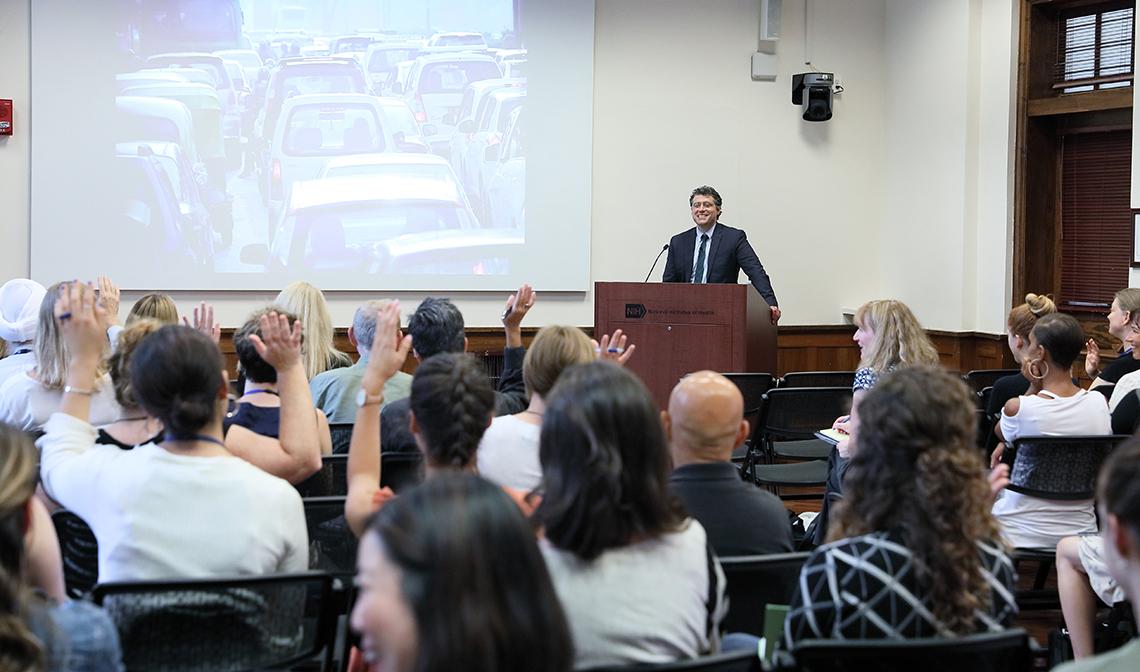A New ‘Field’
Bratman Describes Science of Nature’s Effects on Psychological Health

The effects on people of contact with nature—whether outdoors or indoors (as from plants, photos or window views)—is an emerging field of research showing potential to help address important public health problems, said Dr. Gregory Bratman in a recent lecture in Lipsett Amphitheater.
His talk, part of NCCIH’s Integrative Medicine Research Lecture Series, reflects the center’s research interest in emotional well-being as an aspect of health promotion and disease prevention. Bratman, an assistant professor and the inaugural Doug Walker endowed professor at the School of Environmental and Forest Sciences, University of Washington, focuses on the ways nature experience affects human well-being, particularly mental health.
“The impacts of the natural environment on human well-being have been considered in many ways for thousands of years,” he said, from landscape aesthetics to healing gardens in hospitals to religious and spiritual traditions. People worldwide are becoming increasingly disconnected from nature as they spend up to 90 percent of their time inside buildings and vehicles. Several major trends may be associated with this: a rapid increase in urbanization; a marked decrease in nature exposure among urban dwellers; and a rise in mood disorders, which are leading contributors to the global burden of disease and disability.
The state of the evidence on nature contact (also called nature experience or nature exposure) shows promise for a range of psychological and physical health challenges as a treatment or preventive approach, said Bratman. Those benefits are in three domains—mental health, physical health and general subjective well-being—with the amount and strength of evidence varying by topic. A few examples include reduced stress, better sleep, improved mental health, reduced diabetes and obesity and improved immune function and general health. Nature contact also holds promise as an aid for people trying to make healthier lifestyle changes.
In one of his studies, Bratman randomly assigned a group of 60 healthy adult volunteers to take a 50-minute walk in either of two settings: a “nature environment” containing grassland, trees and shrubs, or an “urban environment” of a busy, major street. Participants were tested before and after their walks with self-report measures for affect or mood, emotion regulation (i.e., how they thought about and controlled their feelings) and cognitive function. Compared with the urban group, the nature group, post-walk, showed significant drops in anxiety and negative affect; increases in positive affect; and improved cognitive performance on a working-memory test.
With regard to emotion regulation, Bratman has a particular interest in rumination, which he has introduced as a possible causal mechanism for some nature-contact benefits. Rumination is a process in which people repetitively think about negative aspects of themselves; it is associated with negative mood and a higher risk of depression and other psychological illnesses for some people. Bratman did a later study that was similar in design, but increased the walk to 90 minutes. His team found, post-walk and in the nature group only, decreases in self-reported rumination and in blood flow to the brain region associated with rumination (the subgenual prefrontal cortex). The urban group showed no significant changes. These exploratory studies were small and Bratman has been pursuing this line of research further.

The authors’ other recommended domains were exposure science, epidemiology, “technological nature” such as virtual reality, diversity and equity issues regarding access to nature, economic and policy studies and implementation science. The individual and cultural differences between people with respect to nature contact is another area to study.
“This field is new, and there’s a lot of work to be done,” Bratman concluded. “But we can say, with some degree of certainty, that in many cases nature experience benefits mood and cognitive function for urbanites (and likely emotion regulation as well, although that is less studied). Rapid change and degradation of natural landscapes across the globe provide critical context for the application of this knowledge. In this way, we can recognize our natural systems as vital assets, account for the roles they play in supporting human psychological well-being and routinely incorporate these values in the decision-making process as we consider how to bring people to nature and nature to people.”
